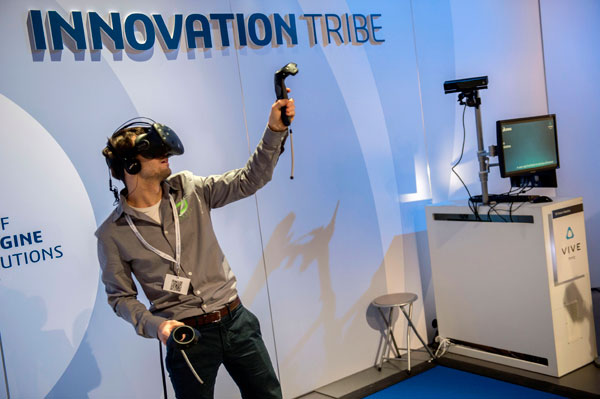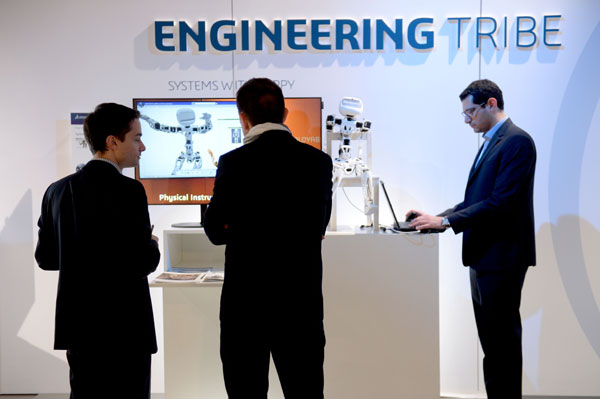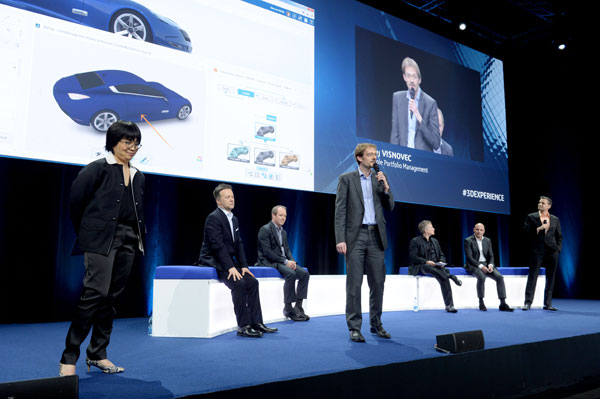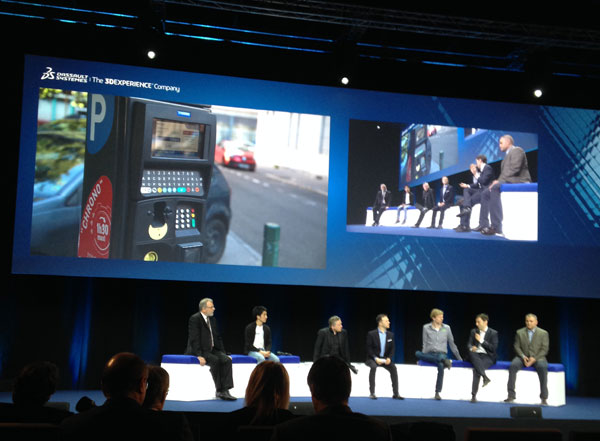
Conference attendees could try out the HTC Vive virtual reality immersive system. Image courtesy of Dassault Systèmes.
April 21, 2016
 The engineering “tribe” was one of four sections of the 3DEXPERIENCE Playground. Image courtesy of Dassault Systèmes.
The engineering “tribe” was one of four sections of the 3DEXPERIENCE Playground. Image courtesy of Dassault Systèmes.Day One at the Dassault Systèmes Global User’s Conference (April 11-12 in Milan, Italy) continued with a virtual walkthrough a day in the life of John, a typical consumer in today’s connected world. We saw how he benefits from the end results of the design experience when listening to music, using an electric toothbrush, brewing fancy coffee, controlling a smart thermostat and communicating with colleagues while driving his connected car.
 Dassault Systèmes CATIA COO, Cécile Doan, led a discussion of how various aspects of the 3DEXPERIENCE came together to support a global automotive design project. Image courtesy Dassault Systèmes.
Dassault Systèmes CATIA COO, Cécile Doan, led a discussion of how various aspects of the 3DEXPERIENCE came together to support a global automotive design project. Image courtesy Dassault Systèmes.John’s car served as the starting point for a fascinating demonstration of automotive design exploration. Led by Cécile Doan, VP Global Brand Advocacy, Dassault Systèmes, a globally connected team began the process using the recently announced, Dassault Systèmes’ XDesign cloud-based CAD package, which leverages the 3DEXPERIENCE platform. Doan stepped the audience through redesigning the car door to open gull-wing style: pulling similar hinge mechanisms off the internet, sorting the designs by weight and cost, mating them with the existing 3D car frame CAD file, then replacing the concept with real parts. Still working in the connected world, other team members used CATIA Mechanical Systems software to validate non-interference and CATIA Natural Sketch to make styling changes to the car’s hood.
Attendees were then invited to try out these software tools and more in the 3DEXPERIENCE Playground section of the conference, divided into four “tribes” encompassing innovation, design, engineering and business aspects. A popular interactive exhibit in the innovation tribe let users try out the HTC Vive virtual reality immersive system. With a digital body scan as the starting point, the user could “draw” and “paint” in the air with the Dream Sketcher system, putting themselves into on-screen fantasy settings from scuba diving to flying that viewers saw comprising different line colors and widths.
 Conference attendees at Design in the Age of Experience had a great time using the Dream Sketcher system and HTC Vive virtual reality controls. Image courtesy Dassault Systèmes.
Conference attendees at Design in the Age of Experience had a great time using the Dream Sketcher system and HTC Vive virtual reality controls. Image courtesy Dassault Systèmes.The conference was then split into six brand strategy sessions, one for each of the primary 3DEXPERIENCE design-related software packages; I attended the one on SIMULIA presented by Scott Berkey, CEO SIMULIA. Berkey noted that across many industries, although styling is a critical factor, that style must perform against specific criteria. A product’s appearance (visual definition) must be translated into a manufacturable design (material assignment plus process choice, such as blow molding) that has a certain strength and durability (simulate for virtual testing).
Engineers can now simulate the performance of a shoe sole, the integrity of a building vs. earthquakes, and even the intricacies of a beating human heart. Berkey provided two impressive examples of the benefits of design coupled with simulation: Amcor Limited, a manufacturer of blister-packs for pharmaceuticals, reduced raw material usage by 27%, and Coca-Cola reduced the time to develop a lightweight bottle by 75% compared to previous design/prototype/test cycles without simulation.
Bernard Charlès, president and CEO of Dassault Systèmes, wrapped up the first day’s events by characterizing design as “the intersection of art, technology and science” in four complementary ways. The first is an holistic approach: Charlès cited how his company originally focused on individual digital parts as assembled into products, but now views both parts and assemblies in the context of the full human experience. Second, design is multidisciplinary, often encompassing mechanical behavior, material properties, electrical connections and more. Third, successful design projects proceed in parallel with simulations, simultaneously testing each iteration against real science, such as fluid dynamics. And fourth, today’s design taps the power of the cloud for instantaneous results and flexible use of resources.
Charlès stressed that all of these elements are accessible even for small and medium businesses, noting that 90% of SOLIDWORKS business is with companies using fewer than five seats of the software. Yet SOLIDWORKS offers complex simulation capabilities including non-linear behavior.
“The industry is going through a wave of change,” Charlès said. “We are seeing things we have never seen before, such as a company of 10 people doing a spacecraft. And who would have said that five companies born in Silicon Valley would build the car of the future?”
More Tales of Transformation
Getting an idea of what it will feel like to ride a Delft Hyperloop train, per Tim Houter, with the #3DEXPERIENCE. pic.twitter.com/1V0T42ORIB
— Desktop Engineering (@DEeditor) April 12, 2016
Day Two of the Dassault Systèmes Global User’s Conference witnessed an intense agenda of presentations by both users and Dassault Systèmes staff. The morning’s plenary session featured five widely varying design projects that reflect “experience thinking” and which attendees (and readers) will surely want to follow as they unfold:
- Tim Houter, team captain of the Hyperloop Project at Delft University, described the premise of Elon Musk’s Hyperloop Challenge to build a high-speed ground transportation system that is “as fast as a plane and as convenient as a train.” His university team’s design came in second only to that of MIT; their prototypes will be tested this August and are designed to achieve speeds of 1140 km/h (708 mph), making Amsterdam to Paris in thirty minutes.
- Genta Kondo, co-founder and CEO, Exiii Japan showed a sample of the 3D-printed robotic prosthetic limb whose affordable design his company offers open source.
- Yves Marie Pondaven, CTO of Parkeon, showed his company’s understanding that even the simple task of parking your car at a meter is part of the larger transportation experience. They are developing meters with pollution-sensors and a smart phone app that tells your car where/when a parking space is available.
- Mike Buchli, vice president, Karl W. Schmidt & Associates, is in the business of designing municipal recycling equipment. He says the concept of recycling must be built into product design, and that both consumers and communities must do a better job; for example, currently, only 25% of the US annual market of 50 billion water bottles gets recycled.
- Bill Zahner, CEO A. Zahner Company, a major US building design and fabrication firm, said that architecture definitely cannot be done in isolation — it’s all about social design. Zahner said the design process is greatly simplified by the connectivity offered with the 3DEXPERIENCE, among the design team and with the client.
 Yves Marie Pondaven of Parkeon explained his company’s use of Dassault Systèmes software to develop smart parking meters that make bringing cars into a city an easier process. A better experience is part of invigorating life in city centers.
Yves Marie Pondaven of Parkeon explained his company’s use of Dassault Systèmes software to develop smart parking meters that make bringing cars into a city an easier process. A better experience is part of invigorating life in city centers.Other talks covered such topics as bridging the gap between design and analysis through expert-generated simulation templates; using CATIA Electrical software and the 3DEXPERIENCE to unify and incorporate more electronics in vehicle design; simulating the full manufacturing process of parts made with composite materials; and predicting the performance of 3D-printed powder bed metal parts with software from DELMIA and SIMULIA (the latter capability is targeted for a Q4 2016 release).
Bernard Charlès said it well when he pointed out that today’s design experience “is not just an extrapolation of what has happened in the past — it’s something very different, like 3D printing and using composite materials, and all the elements are coming together.”
More Info
Subscribe to our FREE magazine, FREE email newsletters or both!
About the Author
Pamela Waterman worked as Digital Engineering’s contributing editor for two decades. Contact her via .(JavaScript must be enabled to view this email address).
Follow DE





